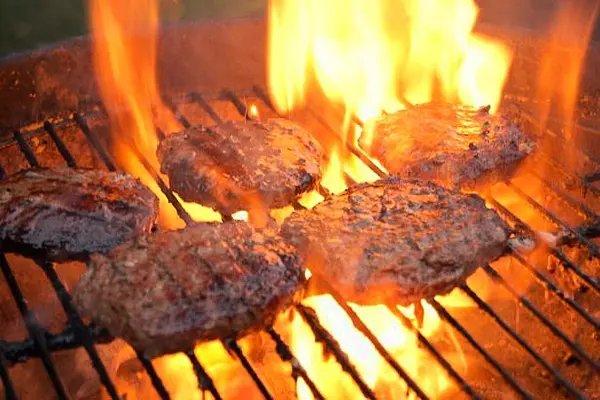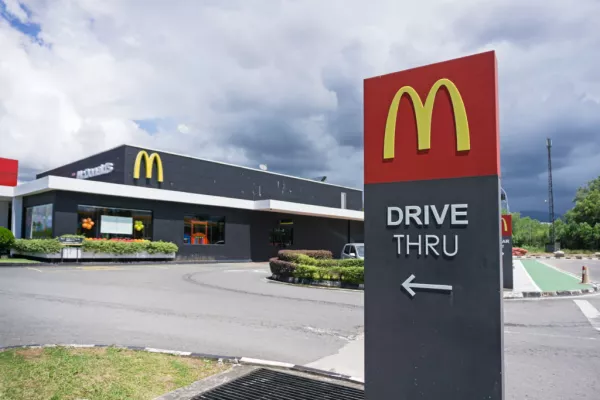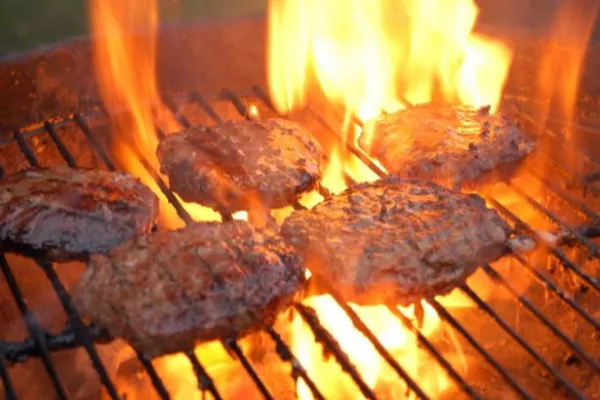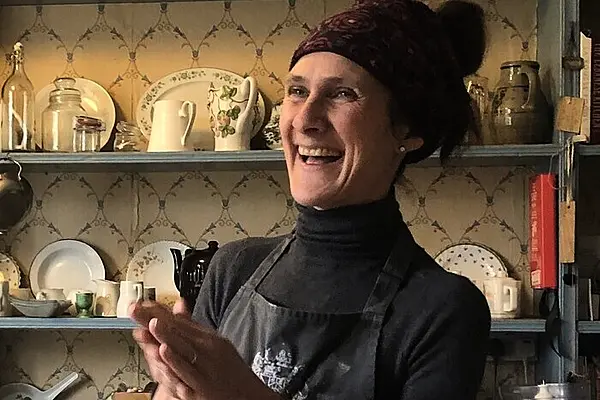“We’re bringing power back to midtown,” says Mario Carbone, the 37-year-old co-founder of Major Food Group. He is sitting at the bar of the Grill, the restaurant that will take over the space of the former Grill Room at the Four Seasons in midtown Manhattan, and at the moment, he is surrounded by menus from revered, mostly long-gone New York establishments such as Jack Dempsey’s, the 21 Club, Toots Shor’s, and the Oak Room.
These menus are inspiration for the decidedly American food he’ll serve at the Grill, Carbone treats the old, worn menus like sacred texts, reciting such dish names as fried scallops in tartar sauce, or roast prime rib of beef with baked potato. “I’m going to serve that,” he says, softly.
For Carbone and partners Rich Torrisi and Jeff Zalaznick, the past has been a key component of their winning restaurant formula, particularly at their power dining room, Carbone. There, the trio transformed the cliché of an Italian-American red-and-white tablecloth dining room into high style, with Zac Posen-clad waiters, walls of Julian Schnabel art work, and fancy Caesars tossed tableside.
At the Grill, which will open on May 4, chef Carbone is evoking the 1940s and ‘50s, when elevated American food was first coming into its own, and a restaurant in midtown didn’t have to have a Le or La in front of its name to be fashionable. Torrisi will be the chef in charge of the more modern, tropically minded the Pool, opening in July. A third restaurant downstairs, yet to be named, is being designed by architect Peter Marino as a late night destination and is slated to open in the fall.
For Carbone, Jack Dempsey’s is the place on which he is most fixated. Dempsey, a boxer-turned-restaurateur, created a chophouse with seafood cocktails, caviar, and crudite; he was masterful at working the dining room, greeting all the celebrities who flocked there. At least that’s the image Carbone has concocted—the one he wants to recreate.
“I look at menus and I tell myself stories,” confesses Carbone. “Back in the day, people like Jack Dempsey, they were ultimate hosts, they made it all about the show, all about the amenities and the options. Guests were king. That’s the way it’s going to be here.”
Torrisi and Carbone are two of the most talented cooks in a city packed with MVP cooks, but the Grill will not be a chef-driven restaurant. Power will be wielded by the dining room captains clad in crisp Tom Ford tuxedos (whose street value is around $6,000). “We wanted to work with the greatest American designer to dress the team who would be working in the greatest American restaurant space,” is how Zalaznick describes the Ford partnership. The former Gucci and Saint Laurent creative director is dressing the entire staff: Managers wear charcoal-and-blue window pane suits; captain’s assistants are in sharp white, mandarin-collared jackets.
All of this has cost a good amount of money, a reported $30 million in the partnership Major Food Group has made with landlord Aby Rosen. Zalaznick doesn’t dispute that number. “You can look at it as three $10 million restaurants,” he says. Though Midtown is not the wasteland people assume—the Polo Bar continues to pack people in, the myriad steakhouses aren’t empty, and the new Empellon is wall-to-wall with expectant diners—the neighborhood has not had anything on this power-dining level since July, when the old Four Seasons restaurant in this space closed.
The Menu
Almost everything on the Grill’s menu is a dish you might have seen on a menu 60 years ago, as defined by Carbone and the team. There are almost 100 selections: Major ingredients, such as lobster and filet mignon, are each offered three different ways; there’s an entire section for potatoes and one for dessert souffles.
Playing a starring role on the Grill stage will be the Buffet (yes, in capital letters). But "buffet" does not means a station that people can wander up to, plates in hand, as in Vegas. This one will display assorted appetizers, from hams to marinated anchovies and daily pickles, as well as some of the more photogenic desserts, including an array of cakes. The menu is à la carte. “I hope I never do a tasting menu again,” says Carbone. “I’ve lost my love for it.”
The appetizers section of the menu is divided into cold (steak tartare and littleneck clam cocktail) and hot. There will be a daily shellfish special; on a recent pre-opening day, Scottish langoustines were served on a silver seafood platter, with dishes of homemade tartare, cocktail, and dijonnaise sauces. Alongside was a small antique salt shaker filled with a house seasoning mix called New Bay. “It’s our version of Old Bay,” explained Carbone. “Squeeze a little lime, a little shake shake with the seasoning mix, and you are good to go.”
Among the menu’s hot appetizers are blue crab gumbo, wild mushrooms omelets that are made tableside and a dish called Pasta à la presse, the only pasta dish on the menu. It’s made with an eggy tagliatelle topped with sauce made from the roasted wings and legs of the assorted birds on the menu and passed through a duck press.
The seafood section features three styles of Dover sole, including the Riviera, which has a creamy sauce with grapes, olives, artichoke hearts; fileted tableside, it will go for around $75. In steaks, the Filet Mignon à la Mode offers one preparation as the Peconic, a surf-and-turf option with smoked oysters and an herb-butter sauce that benefits from the fire-accented juices of the shellfish; it will sell for around $54.
The Prime Rib Trolly service features a custom-made, heavy lidded cart, with compartments for dressings; it will cost around $62. Cakes and tarts include cherry melba, a vibrant, mint-green, ice cream-filled grasshopper Charlotte. Zalaznick is anticipating check averages of $150, about what the tab comes to at Carbone.
The Room
You would have to be compulsively detail-oriented to spot changes in the look of the Grill from its former incarnation. That's because it isn't: The design, by Philip Johnson and Mies van der Rohe, is one of the city’s few landmarked interiors. The French walnut walls, fashioned from a single tree, remain in place after a cleaning, along with the beaded curtains and Richard Lippold sculptures. (A little known Four Seasons fact: The sculpture that hangs over the dining room was originally designed to recreate the shadow of the New York skyline against the setting sun, but new buildings cut off the light.)
The team did update the chairs at the bar—the new version is bronze, with horse hair. The restaurant chairs are designed by Knoll, the same designer Johnson worked with for the originals, to the same specifications.
The bar will feature cocktails that won’t be much different from what people were drinking 60 years ago. The list is strong on martinis; also look for such classics as the Alaska, Tuxedo, and Pink Gin from Thomas Waugh, who also did the bar program at Carbone and ZZ’s Clam Bar.
On the Table
For the Grill, Carbone has found a muse in John F. Kennedy, who ate at the Four Seasons on the night Marilyn Monroe famously sang Happy Birthday to him at Madison Square Garden. Carbone researched the plates from the Kennedy administration. He discovered that First Lady Jacqueline Kennedy had been working on a design with Lenox (which has crafted plates for nearly every president) but the order was completed after the president's assassination. The ivory-colored plates that Lenox made for Carbone have a special stamp on the bottom: "Presidential Service, made exclusively for The Grill." They’re exactly what Jackie Kennedy might have used for state dinners at the White House; the only thing missing is the presidential seal.
Another staple of the dining room is what must add up to over a ton of elegant silver service, from fish trays to seafood platters. The silver sauce boats alone take up multiple shelves. “Everything here has to be polished,” says Carbone. “I say that word a lot. Polish, polish, polish.”
The items most likely to be stolen are surely the steak knives, made by Salter with a golden, Hawaiian, curly wooded handle. How much do they cost? “A lot,” says Carbone. “I can’t imagine there’s a more expensive steak knife in the world.”
The Extras
If the Grill looks as if it got a facelift that smoothed out a few wrinkles without fundamental changes, the primary private dining room has gotten a bigger makeover. A new table custom-made from concrete with a marble top anchors the space. Like those in the dining room, the chairs were made by Knoll to evoke the original wooden Hans Wegner chairs.
What really updates the room, though, is the art. A pair of abstract Lee Krasner paintings, which the partners got on loan from the Krasner foundation, face each other. Krasner painted them in 1959, the year the original restaurant opened, and the room is now unofficially known as the Krasner room.
Not all the spaces feature monumental art, though. The corridor formerly known as Picasso’s Alley, which connects the Grill and the Pool, has been replaced by a living-plant wall sculpture by artist and landscape designer Paula Hayes.
The watchword throughout the Grill is simplicity. Take the burger, which will be served only at lunch. There’s no vaunted blend of 70 percent this, 30 percent that—it’s house ground brisket, says Carbone. “The whole philosophy of the Grill is getting away from overcomplicated food. Enough is enough.” When Carbone argued against a slice of Kraft American on top of the patty, Zalaznick said, “We didn’t want to be the guys who serve the Cheddar cheese burger.” The compromise: top it with housemade American cheese. “Soignée,” pronounces Zalaznick.
No one will be seeing that burger, or any lunch business, for a while: The Grill won’t start serving at midday until mid-summer. While the old Four Seasons created and epitomized the power lunch, the Grill is focused on the idea of midtown power dining in general—and power dinner, in particular. “Diners have been avoiding this neighborhood for years now. Bringing dinner back is crucial,” affirms Carbone. “This needs to be a dinner restaurant,” adds Zalaznick. “Lunch is an amenity.”
The team is betting on the neighborhood’s burgeoning billionaire apartment buildings and business people to take advantage of the proximity. They’re also thinking the Upper East Side crowd will be happy to make a shorter trip rather than go downtown, and that they can lure downtown diners to 52nd Street. For the first time, the space will feature live music, with '50s and '60s R&B and jazz bands playing in the soon-to-open Pool Lounge. “It’s going to be a definite party vibe throughout,” promises Carbone.
News by Bloomberg, edited by Hospitality Ireand









